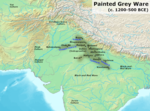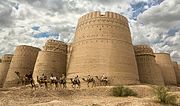The Cemetery H culture was a Bronze Age culture in the Punjab region in the northern part of the Indian subcontinent, from about 1900 BCE until about...
10 KB (1,040 words) - 16:18, 5 October 2024
migrations. It was named after a cemetery found in "area H" at Harappa. According to Kenoyer, the Cemetery H culture "may only reflect a change in the...
58 KB (6,417 words) - 18:47, 20 August 2024
of the Cemetery H culture and Black and red ware culture (BRW) within this region, and contemporary with the continuation of the BRW culture in the eastern...
18 KB (1,841 words) - 02:37, 7 November 2024
Indus Valley Civilisation (redirect from Indus Valley Culture)
that correspond to a regional culture called the Cemetery H culture. At the same time, the Ochre Coloured Pottery culture expanded from Rajasthan into...
191 KB (21,640 words) - 20:36, 15 November 2024
during this decade. The Cemetery H culture had developed by this time in northern India: distinguishing features of this culture include the use of cremation...
3 KB (391 words) - 11:53, 24 March 2024
Jhukar phase (redirect from Jhukar culture)
Jhangar culture (1900 - 1500 BCE). Cemetery H culture (subculture of Late Harrapan IVC phase) in Punjab was contemporaneous to Jhukar-Jhangar culture (subculture...
3 KB (393 words) - 17:18, 25 September 2024
Rakhigarhi (section Cemetery and burial sites)
civilisation Pottery in the Indian subcontinent Bara culture, subtype of Late-Harappan Phase Cemetery H culture (2000-1400 BC), early Indo-Aryan pottery at IVC...
45 KB (4,471 words) - 23:35, 21 October 2024
Harappa (category Culture of Punjab, Pakistan)
Harappan civilisation centred in Sindh and the Punjab, and then the Cemetery H culture. The city is believed to have had as many as 23,500 residents and...
24 KB (2,546 words) - 07:45, 7 November 2024
Indus Valley civilization comes to an end but is continued by the Cemetery H culture c. 1700 BC: Minoan Old Palace period ends and Minoan Second Palace...
5 KB (538 words) - 16:17, 23 June 2024
Outline of ancient India (redirect from Culture of ancient India)
urbanisation" Ahar–Banas culture (c. 3000 – c. 1500 BCE) Ochre Coloured Pottery culture (c. 2600–1200 BCE) Cemetery H culture (c. 1900–1300 BCE) Iron Age...
12 KB (1,044 words) - 07:45, 29 August 2024
subcontinent Bara culture, subtype of Late-Harappan Phase Black and red ware, belonging to neolithic and Early-Harappan phases Cemetery H culture (2000-1400...
34 KB (4,552 words) - 06:15, 19 November 2024
Indus Valley civilisation comes to an end but is continued by the Cemetery H culture. 1700 BC: Belu-bani became the King of Assyria. c. 1700 BC: Minoan...
6 KB (683 words) - 17:35, 18 July 2024
Jhangar phase (redirect from Jhangar culture)
Jhangar culture (1900–1500 BCE). Cemetery H culture (subculture of Late Harrapan IVC phase) in Punjab was contemporaneous to Jhukar-Jhangar culture (subculture...
3 KB (312 words) - 19:48, 6 June 2024
Parpola, the presence of black-red pottery also suggests links with Cemetery H culture in Punjab. The burial of bodies, the metal pins used for fastening...
20 KB (2,267 words) - 16:17, 15 August 2024
ISBN 9788190592802. Stiebing, William H. Jr.; Helft, Susan N. (2018). Ancient Near Eastern History and Culture (3rd ed.). Routledge. ISBN 978-1-134-88083-6...
63 KB (6,232 words) - 08:53, 21 November 2024
Civilization comes to an end but is continued by the Cemetery H culture; The beginning of Poverty Point culture in North America. 1600 BC: Minoan eruption destroys...
44 KB (5,026 words) - 08:33, 11 November 2024
the IVC and later Hinduism. I am now more than ever persuaded that IVC culture survived the destruction of its cities and that later Hindu imagery, having...
55 KB (5,919 words) - 04:07, 4 November 2024
BC) Yaz culture (1500–1100 BC) Indian subcontinent Ochre Coloured Pottery culture (2000–1500 BC) Cemetery H culture (1900–1300 BC) Swat culture (1400–800...
57 KB (5,437 words) - 21:53, 18 November 2024
Bhirrana (category Archaeological cultures in India)
civilisation Pottery in the Indian subcontinent Bara culture, subtype of Late-Harappan Phase Cemetery H culture (2000–1400 BC), early Indo-Aryan pottery at IVC...
21 KB (2,069 words) - 17:22, 17 November 2024
historical sources. The culture includes three closely related cemeteries: the Subeshi cemetery the Shengjindian cemetery, the Yanghai cemetery. After 200 BCE...
26 KB (2,791 words) - 14:56, 12 October 2024
Harappan Civilization, which developed c. 3000 BCE from the prehistoric Indus culture. At its height, the Indus Civilization spanned much of what is now Pakistan...
42 KB (4,673 words) - 07:15, 20 November 2024
the fragmentation of the culture of the Integration Era. The Localisation Era comprises several phases: Punjab Phase (Cemetery H, Late Harappan). The Punjab...
27 KB (2,793 words) - 16:19, 5 October 2024
2nd millennium BC (section Prehistoric cultures)
Central Asia Andronovo culture Oxus civilization East Asia Erlitou culture Wucheng culture South Asia Ahar–Banas culture Cemetery H culture Indus valley civilization...
20 KB (1,571 words) - 19:12, 17 October 2024
prescribing cremation. Cremation in India is first attested in the Cemetery H culture (from c. 1900 BCE), considered the last phase of Indus Valley Civilisation...
98 KB (11,917 words) - 07:28, 17 November 2024
province of Pakistan. The river has historically been important to many cultures of the region. The 3rd millennium BC saw the rise of Indus Valley Civilisation...
73 KB (7,415 words) - 19:09, 16 November 2024
The Ochre Coloured Pottery culture (OCP) is a Bronze Age culture of the Indo-Gangetic Plain "generally dated 2000–1500 BCE," extending from eastern Punjab...
14 KB (1,318 words) - 16:19, 5 October 2024
identified as corresponding in part to the Northern Black Polished Ware culture. The term "Janapada" literally means the foothold of a people. The fact...
43 KB (5,108 words) - 04:20, 7 November 2024
Lothal (section Economy and urban culture)
essentially a single culture site—the Harappan culture in all its variances is evidenced.[citation needed] An indigenous micaceous Red Ware culture also existed...
53 KB (6,429 words) - 22:17, 18 November 2024
the Cemetery H culture which grew as a surviving regional variant of the Harappan culture, which was then followed by the Painted Grey Ware culture. The...
23 KB (2,517 words) - 10:49, 9 November 2024
civilisation Pottery in the Indian subcontinent Bara culture, subtype of Late-Harappan Phase Cemetery H culture (2000-1400 BC), early Indo-Aryan pottery at IVC...
28 KB (1,334 words) - 19:45, 20 November 2024
























